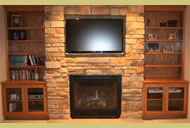FAQ's
- Do you charge for an estimate?
- All estimates are free of charge.
- What is the service area of Lakeville Fireplaces?
- We service the entire metro area within in a 50-mile radius.
- Do you have a showroom?
- We work closely with two showrooms in the metro area, conveniently located in Jordan and Burnsville.
- Can I convert my wood-burning fireplace to a gas fireplace?
- Yes. We have gas inserts designed for both masonry and factory-built wood-burning fireplaces.
- How do I know if I need an insert or a fireplace?
- If you already have a brick or stone fireplace or a factory built fireplace and you want to convert it to gas, then the most cost effective solution is an insert. If you are remodeling your home that does not have a built-in structure, then you need a direct vent fireplace that does not require and existing opening or chimney.
- What is the difference between a B-Vent and a Direct Vent fireplace/insert?
- A B-Vent and Direct Vent distinguishes how a gas appliance takes in air it needs to burn the gas. A B-Vent draws air from inside the home through ports in the firebox. A Direct Vent draws in outside air through a pipe into a sealed firebox.
- What type of vent is best for newer, airtight homes?
- Direct Vent is usually safer and better for newer homes because they do not cause conflict with range hoods and bathroom circulating fans already circulating air.
- What is a BTU?
- BTU is short for British Thermal Unit. It refers to the power of a gas appliance as measured the amount of energy it produces in one hour. It is the amount of heat required to raise the temperature of one pound of water by one degree Fahrenheit. On average, a 10,000 BTU component can heat up approximately 500 square feet, taking into consideration the floor plan, ceiling height, quality of windows, and type of flooring.
- How often should I have my fireplace serviced?
- Every year by a professional.
- Should I leave my pilot light on in the summer when my fireplace is not in use?
- Running the pilot light year-round will extend the lifespan of the generator by not allowing condensation and corrosion to build up inside.

